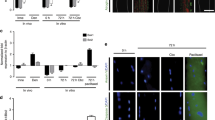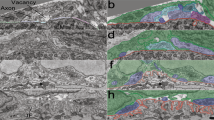Abstract
MUSCLE fibres will accept innervation from a foreign nerve only if synaptic transmission from the appropriate nerve has been interrupted1. The native nerve supply thus exerts an influence which renders muscle resistant to abnormal innervation. Do such influences act to prevent neurones from receiving inappropriate synapses ? In the central nervous system (CNS) surviving inputs to partially denervated neurones will sprout to form additional synapses on those same neurones2–4. Furthermore, in partially denervated autonomic ganglia, surviving inputs will sprout to form synapses on postganglionic neurones they did not innervate originally5–7. But there has been no electro-physiological demonstration that denervated neurones will spontaneously receive synapses from a class of nerve cells with which there is normally no contact. We report here that the parasympathetic ganglion cells of the frog heart form functional synaptic connections with each other when their preganglionic synaptic input is removed; these intraganglionic connections do not occur normally.
This is a preview of subscription content, access via your institution
Access options
Subscribe to this journal
Receive 51 print issues and online access
$199.00 per year
only $3.90 per issue
Buy this article
- Purchase on Springer Link
- Instant access to full article PDF
Prices may be subject to local taxes which are calculated during checkout
Similar content being viewed by others
References
Elsberg, C. A. Science 45, 318–320 (1917).
Raisman, G. & Field, P. M. Brain Res. 50, 241–264 (1973).
Cotman, C. W. & Lynch, G. S. in Neuronal Recognition (ed. Barondes, S. H.) 69–108 (Plenum, New York, 1976).
Tsukuhara, N., Hultborn, H., Murakami, F. & Fujito, Y. J. Neurophysiol. 38, 1359–1372 (1975).
Murray, J. G. & Thompson, J. W. J. Physiol., Lond. 135, 133–162 (1957).
Courtney, K. & Roper, S. Nature 259, 318–319 (1976).
Purves, D. J. Physiol., Lond. 261, 453–475 (1976).
McMahan, U. J. & Kuffler, S. W. Proc. R. Soc. Lond. B 177, 485–508 (1971).
Dennis, M. J., Harris, A. J. & Kuffler, S. W. Proc. R. Soc. Lond. B 177, 509–539 (1971).
Kuffler, S. W., Dennis, M. J. & Harris, A. J. Proc. R. Soc. Lond. B 177, 555–563 (1971).
McMahan, U. J. & Purves, D. J. Physiol., Lond. 254, 405–425 (1976).
Roper, S. J. Physiol., Lond. 254, 427–454 (1976).
O'Lague, P. H., Obata, K., Claude, P., Furshpan, E. J. & Potter, D. D. Proc. natn. Acad. Sci. U.S.A. 71, 3602–3606 (1974).
Ko, C. P., Burton, H., Johnson, M. I. & Bunge, R. P. Brain Res. 117, 461–485 (1976).
Author information
Authors and Affiliations
Rights and permissions
About this article
Cite this article
SARGENT, P., DENNIS, M. Formation of synapses between parasympathetic neurones deprived of preganglionic innervation. Nature 268, 456–458 (1977). https://doi.org/10.1038/268456a0
Received:
Accepted:
Issue Date:
DOI: https://doi.org/10.1038/268456a0
This article is cited by
-
Culture of intramural cardiac ganglia of the newborn guinea-pig
Cell and Tissue Research (1986)
-
Disorganised and ‘excessive’ reinnervation of frog cardiac ganglia
Nature (1978)
Comments
By submitting a comment you agree to abide by our Terms and Community Guidelines. If you find something abusive or that does not comply with our terms or guidelines please flag it as inappropriate.



